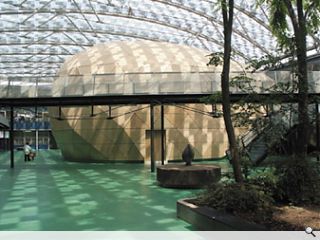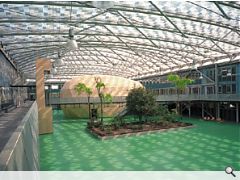Building school success
14 Sep 2004
Kingsdale School has been held up as an exemplar of good practice in school design – but will this experimental approach stand the test of time?
Kingsdale School in south London is a success story. Its dynamic head, Steve Morrison, has reversed a decline in exam results and restored the school’s spirit and reputation.
A part of that success is the outcome of a novel experiment in school building, architecture and consultation. Kingsdale teamed up with School Works, set up by Hilary Cottam of the Design Council, got input from the New Labour Think Tank, Demos, and the Architecture Foundation, commissioned the architects de Rijke Marsh and Morgan, and then asked the pupils what they wanted. The outcome is a transformed school building which has won compliments all round. At least, that is the official version.
The big input was the £12 million from the Government’s regeneration budget. The money was there to show that New Labour cared about education, and it paid for the refurbishment. By the 1990s, Kingsdale was dilapidated, and it was also demoralised – two things which, though they might influence one another, are not the same.
The school was built by Sir Leslie Martin’s London County Council team – creators of the Royal Festival Hall, and opened in 1958. Champions of today’s refurbishment, like Jonathan Glancey, dismiss Martin’s modernist building for its narrow corridors and bad design. Architect Alex de Rijke goes as far to say that “the school was a mistake born out of a socialist dream”. But actually it was a fantastic building and when I went there in 1973 we were in awe of its science-fiction grandeur: the great oblong box of concrete and glass surrounded an open quad, with its cutaway entrance running under the first-floor classrooms, the broad, glass-enclosed concrete stairwells. Its great hall (now demolished), with sunken floor, was a triumph of post-war architecture. Of course, we knew it was alienating, too. But that was part of its appeal. It was a set from Truffaut’s “Fahrenheit 451”, or Kubrick’s “Clockwork Orange” (though you could only see that in a book of stills at that time). We called the tannoy system Big Brother. Today the head has a permanent tape loop of the school’s achievements running in the foyer, smacking of much the same megalomania.
Visiting the school earlier this year, architect Philip Marsh told me that one of the difficulties of working with the old school was that, like most buildings put up just after the war, there were material shortages, and Martin’s team had been innovative in scrimping. Floors were thin scree, and the walls were an innovative honeycomb of plaster, covered in a plaster skin. The honeycomb effect was familiar to me from a hole we had kicked into the wall of our form room, just by the door jam, big enough to squeeze through if the teacher was late for registration.
Kingsdale in the 70s was scruffy and raucous. In 1970 it was attacked by a mob up from Tulse Hill School, after skirmishes in town. On the last day of the spring term, children not taking exams could leave, their surliness multiplying the usual flour-throwing. Once, they barricaded themselves into the headmaster’s office and played reggae music over the school tannoy system. Many of the children’s complaints to the recent dRMM consultation exercise feel familiar – stinky toilets, dark locker areas and overcrowded corridors. But none of these would have added up to a failing school.
By the 1990s, though, Kingsdale was under the DfE’s ”special measures” for its poor attendance, and for getting just a seventh of its pupils through five GCSEs in 1999. In 1994 one boy was sent to a young offenders institute after stabbing another in the school. The backdrop to Kingsdale’s decline is less to do with the building than it is to do with the depopulation of London schools. As people have moved out to the suburbs, pupil rolls have been falling. In 1990, Tulse Hill was closed, followed by William Penn (“Billy Biro” to us, before it was renamed Dulwich High School), whose pupils were sent to Kingsdale. Problematically, the falling school numbers and the introduction of parental choice have left a few children without places, often refusing the choice of last resort: Kingsdale. Head Steve Morrison admitted, “Children have often ended up here, not by design but because there were few other options for them.”
Accounts of Kingsdale at that time verge on the hysterical. But then it is to be expected that reformers should dramatise their own advances by exaggerating existing problems. Alex de Rijke says that Kingsdale was a “mistake” adding that “it is a black school in a white community and a poor school in a rich community”. Around 15 per cent of the school was black in the 1970s and, when I went back, it was about 50 per cent black. We were aware of the wealthy Dulwich College next door, viewing it with a mix of class resentment and awe, but happily snuck out to the square for chips, however alien the community. Deputy head Cathy Bryan is still on duty stopping absconders with a stentorian command that has me shaking. Today, 30 per cent of Dulwich College’s intake is from ethnic minorities. At the turn of the last century, PG Wodehouse spent “six years of unbroken bliss” there. Bob Monkhouse and Peter Lilley were old boys, too. In the 70s we could see the Officer Training Corps over the wall, training for the coup d’état. There is still little interaction between the two schools, but today it is Dulwich College that is over-subscribed, while Kingsdale’s numbers have fallen to 1000.
De Rijke, Marsh and Morgan have made a virtue of art in architecture, and their new auditorium in Kingsdale includes artworks by Dutch design company Atelier Van Lieshout. The auditorium is at the centre of dRMM’s changes: it is a wooden, geodesic pod that mushrooms out of one wall of the quad into the available space. A walkway connecting the first-floor corridors has been put in, along with a (rather awkward) second corridor along the inner walls. The whole is crowned by a transparent skin of ethyl tetra fluoro ethylene (ETFE), which can be adjusted to block sunlight using the same principle as Polaroid glasses.
The pupils’ input has been taken on – separate eating areas for girls (outnumbered four to one at one point), better bogs and lockers – but it has not been the showcase of the project. The truth is that, like any consultation, it is as good as the input, and children just do not have as much to add as we think they do. The think-tank input was a bit arbitrary, too. The pointy-heads at Demos were very critical of the running around at the school bell – though Kingsdale has never had a bell, only tannoyed pips to mark the end of school lessons. In the end, the proliferation of agencies involved only indicated a lack of decisiveness, and an attempt to gird the loins to action. What has caught the critics’ eyes has not been the outcome of the consultations. It has been dRMM’s CAD-led innovations.
But these are also indicative of the project’s weaknesses. The whole feels like it is a contemporary, curvilinear and computerised doodling on top of the LCC’s set-square-drawn, isometrically conceived box – a precise image of post-modernism. Despite the implied contempt for the old building, the new one is not new enough. Sir Lesley would surely have had the courage to knock it down and start again. The effect is striking, but just a bit busy. The pod, too, looked better before the skin was on, with its skeleton revealed.
Site architect Philip Marsh, along with the builders, Galliford Try, are proud of having done the work alongside the pupils, without closing the school. Deputy head Cathy Bryan is pleased to have maintained continuity. But boys I talked to did find the building work distracting. You get the feeling that the school is very defensive – certainly the management team are paranoid about reporters – and dreaded closing down to re-open in new premises, for fear that this would confirm the sense of collapse amongst the pupils.
Instead, Morrison and Rogers have made the story of the school’s re-building into a narrative of re-birth, enjoining the students to follow the process. Like the windmill in “Animal Farm”, it is the building of it, not the completion, that keeps the spirits up. Back in 1999, Morrison said, “If this project works, we will be able to demonstrate a measurable link between improving buildings and improving the performance of pupils.” On the face of things, the project has worked. But that in itself is something of an illusion. Certainly the re-building stands as symbol of the wider society’s interest in the school. But the truth is that buildings do not teach children. Teachers do. The building programme the Government began in 1998 substitutes architecture for advances in education. Better buildings, by all means. But when future generations look back on dRMM’s re-working of Kingsdale, it will strike them as at least as stuck in its own time as Lesley Martin’s original.
Written by James Heartfield, who is is a director of Audacity.org and a former pupil of Kingsdale School.
Read next: Hard to Beat
Read previous: Portis Will Shine in Washington
Back to September 2004
Browse Features Archive
Search
News
For more news from the industry visit our News section.
Features & Reports
For more information from the industry visit our Features & Reports section.




